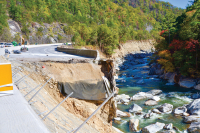A love letter to Appalachia
 File photo
File photo
Editor’s note: This article first appeared online at the website “100 Days in Appalachia.” Meredith McCarroll is from Waynesville, went to Appalachian State and the University of Tennessee and resides in Brunswick, Maine. She is author of “Unwhite: Appalachia, Race, and Film” and co-editor of “Appalachian Reckoning: A Region Responds to Hillbilly Elegy.”
Because I have been writing about Appalachia and representation for a while now, and because I have spent too many words on “Hillbilly Elegy,” I’ve been called upon to offer my opinion on JD Vance now that he is Trump’s vice-presidential pick. So I steeled myself and tried to figure if I had anything new to say.
I’m not sure whether I did, but maybe I found some new audiences this week. But I find myself thinking about and writing to those of you who already know about Appalachia.
I don’t need to remind you of how many states the ARC says defines Appalachia or how many people live in those 13 states or how diverse those 25 million people are. I don’t need to make a case that people in Appalachia don’t think the same way, or that the experience I had in Waynesville, North Carolina, is so different than the experience in Hazard, Kentucky, where the industries and landscape and soft drink of choice are different.
Many of you know how it feels to see a Saturday Night Live skit lazily rely on the same stereotypes from 200 years ago just like you know how it feels to see headlines that Appalachia is being discovered as a new affordable retirement spot. I won’t try to tell you something you already know, something many of you reading this might have taught me.
What I want to offer instead is something like a nod. An acknowledgment. Maybe even a hug. It’s not just you. I see it too. I’m angry and weary and not just at the latest reason that people are looking at Appalachia, but I’m also disappointed in the bifurcation that makes me scared to talk to neighbors about anything from college to healthcare because it has all become politicized to the point of stagnation.
Related Items
It is hard to feel such complicated feelings and to be asked to speak for a place that defies a spokesperson.
At the Republican National Convention, JD Vance introduced himself and gave a speech to a room that felt a lot like a high school gym pep rally with no teachers to hush anyone and no principal to keep order. At one point, after Vance told a story about his Mamaw threatening to run someone over in her car, promising that “no one would know” – the crowd erupted into a chant of “Mamaw. Mamaw. Mamaw.”
It was a strange moment. Though I called my own grandparents Granny and Pa, I knew plenty of Mamaws and Papaws, and there was something refreshing about hearing a room chant this word that feels tied to class and place. A word that doesn’t often find center stage.
That moment of his speech lingered with me as I considered what I knew about his Mamaw from “Hillbilly Elegy.” Like so many grandparents then and now in places most affected by the opioid crisis or third shifts or predatory lending, Mamaw stepped in when she was needed. She was a solid presence for young JD when his mother could not be.
He might have remembered her with this crowd in order to point to some salt of the earth way of seeing her — hardworking and steadfast. Instead, though, he turned his Mamaw into a stereotype, straight off the pages of the funnies or drawn from “The Beverly Hillbillies.” He reduced her to a gun-toting Granny. And the crowd ate it up.
In 1953, Ralph Ellison wrote an essay entitled “Shadow and Act,” in which he said, “For I found the greatest difficulty for a Negro writer was the problem of revealing what he truly felt, rather than serving up what Negroes were supposed to feel, and were encouraged to feel.” Is there a way to understand JD Vance in this context? Might he actually not know what to feel about eastern Kentucky, where his grandparents migrated in and out over his lifetime?
As we move toward a more and more homogenous culture, many of us want to see and understand what it is about our experience of place and family that is unique. Ultimately, we ask who we are and where we came from. Whether on Ancestry.com or by looking through a family tree in the front of a Bible, many Americans seek a deeper understanding of the past in order to see who we are today. And it is easy to rely on the stories we hear.
In fact, we must rely on the stories we hear. That’s all we have.
Some of us have the stability of a great aunt who kept up with second cousins and can tell us who worked where and why a marriage actually broke up three decades ago. But many of us are the product of movement from one place to another — usually for “better jobs” — which often means we lose ties to extended family and aren’t quite sure whether we can still claim place.
A few generations down the line, we have to learn what our people might have been like by watching movies from that place or reading books from those perspectives. But what if the books and movies are not only naively simplifying stories of a place and of a people? What if they are intentionally pedaling an image or narrative to a particular end?
Appalachians like you already know that representation of the region has been a key element to its destruction. When people are portrayed as undeserving — perhaps they are lazy and can’t take care of themselves — it is easy to justify blowing the tops off of their mountains, causing not only instant and permanent wounds but impacting economic prospects for the surrounding areas, creating runoff and reducing surface flow retention so that deadly flash floods are inevitable. When places are scarred, it is easy to look away from them while extracting what is needed from them.
Simply put, the stories we tell about a place matter. The ways that we understand groups of people directly impact how they are treated. So even with nothing new to say about this, even at the end of a week that has left so many of us weary and pessimistic, I can’t let it go.
It may be futile. The horse I’m beating may already be dead. But what else can I do?
It is silly to expect a politician who had a tough childhood in Ohio and eastern Kentucky to fight for the place that he left. It is strategic for him to use his extended family to prop up the story of his success. It is unsurprising that he will say what needs to be said to get elected. I’m done being shocked that JD Vance is making political moves for his own benefit without considering the cost of the stories that he tells.
But I am not done shouting back, challenging the false idea of some sort of unified Appalachia. I am not done pointing out the complexities of this region, highlighting Black, Brown, Queer, migrant stories that are and have been woven into the fabric of Appalachia all along. I insist on trying to show Appalachia as a place that is impossible to define in one article, interview or book.
It is easy to feel defeated. It is necessary to rest. But when you can, look for and share the points of light around you — even if just telling a story to your child or passing a book to a neighbor.
Look through Julie Rae Powers’ new photography collection, “Deep Ruts,” and have your sense of a place joyfully disrupted.
Read stories from Neema Avashia and Michael Croley and Jeremy B. Jones and Annette Saunooke Clapsaddle and David Joy and Crystal Wilkinson and Silas House and Karida Brown and celebrate the contradictions.
Listen to Black in Appalachia and Appodlachia and Read Appalachia to remember the power of self-representation.
Make your way through the archives in Appalshop, read the Foxfire books, and then watch “Hillbilly” or “After Coal” or “Up the Ridge” to see all the ways that self-representation is still a key part of survival.
I might be preaching to the choir here. But this is no eulogy. We needed no elegy.
If I’m preaching here, then I’ll encourage you to turn now to your neighbor. Find someone to remind you where you’re from. Find someone whose experience is nothing like yours. Find someone who inspires you. Surround yourself with people who can see beyond this moment and keep going. Keep reading. Keep writing. Keep watching. Keep filming. Keep singing. Keep loving and holding to account this place and one another.
We are bigger than this moment. We are more than any one of us.













